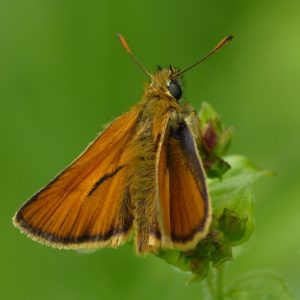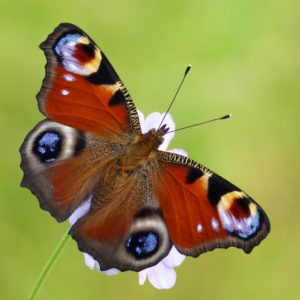
This is part 2 of an exclusive report specially commissioned by Brighton & Hove News on the butterflies of our city and so you may wish to save all of the parts for future reference!

Brighton and Hove Butterfly Sites – Coldean:
Coldean Woods and adjoining grassland clearings:

Overall number of butterfly species recorded on site: Minimum of 19 species.
Site description: Woodland strip and pockets of open grassland off Coldean Lane with the A27 directly behind, along the edge of Coldean Lane the site stretches the full length between (North) Hawkhurst Road and the (South) Lewes Road. Some uneven pathways and sloping terrain.
Main butterfly species to look out for: White-letter Hairstreak, Purple Hairstreak, Brimstone, Comma, Ringlet, Gatekeeper and Common Blue.

Moth species recorded on site: With limited moth trapping the site has seen a tally of seven species of Hawk- moth, these are Privet, Poplar, Eyed, Lime, Small Elephant and Elephant and the day flying Humming-bird Hawk-moth which lays it’s eggs on Hedge/Lady’s Bedstraw plants.
Best butterfly locations: Best butterfly locations are within the woodland clearings and where dappled light reaches the floor, along the woodland edges and the open pockets of chalk grassland.

Travel Directions:
Pedestrian entrances: Various paths that run into the wood along the length of Coldean Lane that run past and open to the pockets of grassland. Main entrance opposite the Hikers Rest at the bottom end of Coldean Lane.

Parking: Saunders Hill/Beatty Avenue at the Northern end of Coldean Lane. The set back stretch of Coldean Lane between Hawkhurst Road and Forest Road and along Park Road towards Lewes Road.
Buses: 5B, 24 and 50U.

Useful information: The friends of Coldean Woods are a group of local residence with a shared interest of the outdoors, working together to improve their local site. The group meets opposite the Hikers Rest Pub at the bottom of Coldean lane at 10am on the second Saturday of every month. Work includes maintaining and creating paths and steps for better access, tree thinning, planting and litter picking.

Brighton and Hove Butterfly Sites – Stanmer/Falmer:
Stanmer Park and surrounding Woodland:

Overall number of butterfly species recorded on site: 26 species, even more butterfly species if you venture onto the surrounding downland behind Stanmer Village.
Site description: Stanmer Park comprises of open flat and sloping grassland where the road, Stony Mere Way cuts through the middle of the park to meet Stanmer Village, Stony Mere Way is accompanied by a number of trees, including Elm which the White-letter Hairstreaks depend upon. On the outer edges of the park, woodland to the East runs along the boundary of the Falmer Campus of the University of Sussex, whilst on the Western side, the dominant woodland called Great Wood has benefited from coppicing by volunteers and the Council Cityparks Rangers.
Main butterfly species to look out for: Common Blue, White-letter Hairstreak, Small Skipper, Silver-washed Fritillary, Marbled White, Ringlet, Purple Hairstreak, Comma, Peacock and Red Admiral.

Main day-flying moth species and caterpillars to look out for: Six-spot Burnet.
Best butterfly locations: Within Great Wood and the other woodland surrounding Stanmer Park, the glades and clearings become alive with a wide range of butterflies in July, including the orange coloured Silver-washed Fritillary, look after 4pm on hot sunny days as they begin to slow down, the butterfly is our largest species which has been recorded in Brighton and Hove. Look out for Purple Hairstreaks in the canopy of Oak trees, seen as small silver triangles as their wings catch the light, most active between 5pm and 7pm during sunny and wind free evenings.

Travel Directions:
Pedestrian entrances: Stony Mere Way from the West or Sportcentre Road from the East coming from the University of Sussex, Falmer Campus, both roads have pedestrian pavements leading to the main entrance of Stanmer Park.
Parking: Parking bays along Stony Mere Way set within Stanmer Park, Stony Mere Way is the next left turning after Coldean Lane heading East, turning off the Lewes Road.
Buses: 5B, 23, 24, 25, 50U and (78 – goes directly to Stanmer Park and Village).
Useful links: http://www.lnr.naturalengland.org.uk/Special/lnr/lnr_details.asp?C=0&N=&ID=1202

About the author of these exclusive reports:
Jamie Burston is a local resident and Brighton based wildlife artist. His highly detailed illustrations are based on photographs that he has taken of local observations of the butterflies he encounters in Brighton and Hove and wider Sussex and thus forming the reference of his drawings and paintings. Visit Jamie’s online shop here: https://www.etsy.com/uk/shop/JamieBurstonArt

Acknowledgment:
Thank you to the following people for providing information towards the article: Jamie Burston, Paul Gorringe, Peter Whitcomb, Geoff Stevens, Tessa Pawsey, Dan Danahar, Annabeth Horsley, Bob Foreman and Neil Hulme (who’s photographs are shown throughout this article).
By popular request, the previous 7 articles can be located by clicking the links below:
Butterflies of Brighton & Hove – Part 1:
Butterflies of Brighton & Hove – Part 3:
Butterflies of Brighton & Hove – Part 4:
Butterflies of Brighton & Hove – Part 5:
Butterflies of Brighton & Hove – Part 6:
Butterflies of Brighton & Hove – Part 7:
Butterflies of Brighton & Hove – Part 8:








Since writing the article, Dr Dan Danahar saw the very first sighting of a Silver-washed Fritillary in Coldean Woods on the 22 July 2017. This suggests an expansion of the butterflies distribution, coming from Stanmer Park’s Great Wood.
Also on the Falmer Campus of the University of Sussex, on 24 July 2017, the first modern day sighting of a White Admiral was recorded within the city by Rich Howorth, as a result it’s now worth searching for this butterfly at Stanmer Park, within the woods and glades on the eastern boundary.